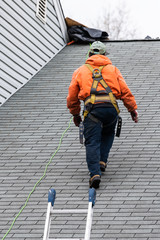A roof inspection is essentially a report which evaluates the condition of your roofing. A roof inspection won’t tell you about the lifespan of the roof, just the required repairs. It would help if you were a qualified and insured roofer to obtain a roof inspection quote. A roof inspection report will show the roof’s condition and the necessary repairs if you want to get the roof back in top shape. A qualified roofer can evaluate the roof based on his experience.


The certified inspectors of roofing usually perform roof inspections. These inspectors have undergone comprehensive training in the application of building regulations and safety codes. The certification ensures that the inspector can perform the job with professionalism. The certification also guarantees that the roof inspection report is correct and complete.
When a roof inspection report from a certified roofing inspector is submitted to you, there should be at least three basic things included. These include physical problems like holes or leaks, material problems such as missing shingles or tiles, and system problems like electrical and plumbing issues. If there are multiple problems with your roof, then the inspection is classified as a system inspection. Your home insurance company may require you to get a roof certification before they approve a claim. In the United States, the National Fire Protection Association (NFPA) provides roof inspection certification.
When it comes to roof problems, often the roof installation is to blame. When the roof inspection report indicates roofing problems, then the claim will probably be rejected. Homeowners need to remember that most shingles’ average lifespan on a single house is less than five years, so flashing is not likely to wear down that fast.
As soon as the roof inspection determines at least three possible roof moisture sources, the next step is to perform an interior inspection. You should check for evidence of any water penetration, leaky pipes, or faulty insulation during an interior inspection. Examine the attic to check for insulation condensation, and check around the foundation for damage. Remember that the attic is typically more susceptible to moisture damage because it is less protected from the elements.
If you perform a roof inspection and find no evidence of water penetration, leaks, or condensation, then you will have to perform the final inspection called an exterior inspection. If you find evidence of any of these problems, you should make sure that you fix these problems before submitting your claim. The exterior inspectors check for signs of mold, mildew, or moss. Some mold signs are discolored in the ceilings or walls, making it hard to tell if it is actually molded. Mildew and moss can cause costly remediation costs and aggravate the homeowner’s allergies.
If you find evidence of damage, such as holes or missing shingles, you should repair these problems right away to prevent further damage during your roof inspection. If you find discolored spots or patches of missing shingles, make sure you address these issues before you submit your claim. If your home has just been damaged, then you may be able to save some money by repairing your home yourself. However, it is important to remember that repairing your home yourself usually increases the repair costs substantially.
In conclusion, roof inspections are necessary to help ensure that your home is safe. When you have your roof inspected by a qualified roofing contractor, you can rest assured that your home will be safe from weather-related damages and other problems. If you need some additional information about this process, you can contact your insurance company or your local roofing contractor. In many cases, these companies can provide you with a free roof inspection estimate, which will give you an idea of what additional repairs you may need to pay for.